Summary: Before starting to develop an AI strategy, make sure your team understands the limits of what is reasonable today, as well as incremental improvements that might be overlooked. Focus should be on your LOB leaders who understand the business. Make sure they are also able to recognize AI opportunities.
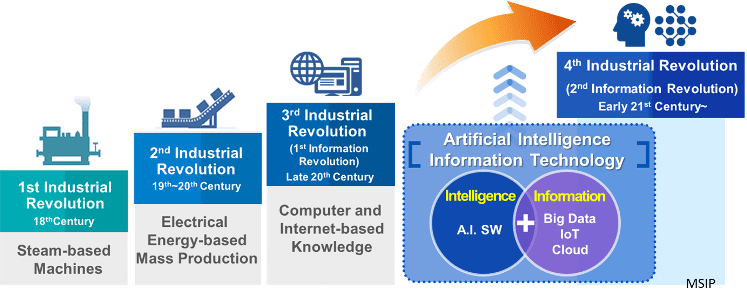
I recently saw this chart from PricewaterhouseCoopers as part of their ‘2018 AI Predictions Report’. The statement was: ‘we effectively utilize all the data we capture to drive business value’ (strongly agree – ~2200 C-level and IT respondents in large and mid-size companies internationally).
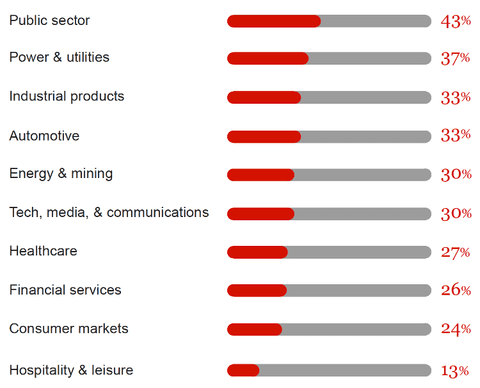
Keep in mind that the survey was done with future applications of AI as its focus. What immediately struck me is that these responses are almost exactly the inverse of what we should expect.
Hospitality, consumer, and financial services are by far the most intensive users of predictive analytics. Conversely, for the public sector and utilities to give themselves such glowing reports about the effectiveness of their data usage seems – well – not to put too light a touch on it, preposterous.
The way I believe this should be interpreted is that those with the lowest scores see the biggest potential benefit from advances in data science.
To be specific, our bottom three ‘leaders’ (hospitality, consumer, financial services) were all among the earliest and deepest adopters of predictive analytics. This means to me that they have the most well developed teams and deepest history with its business value both strategic and tactical, and are therefore most likely to be open to the newest advances in deep learning (aka artificial intelligence).
Why Limit AI Strategy to Deep Learning
To be candid, the only technologies in AI that are commercially ready today are convolutional neural nets (CNNs) for image/video classification, and recurrent neural nets (RNN, LSTM, GRUs) used for sequence problems like text and speech recognition and translation.
Without CNNs and RNNs we wouldn’t have facial recognition, chatbots, personal assistants, instant translators, Alexa, Siri, or visual search and classification capabilities in our recommenders.
There are plenty of other exciting developments in AI underway but they’re just not ready yet for broad commercial rollout. 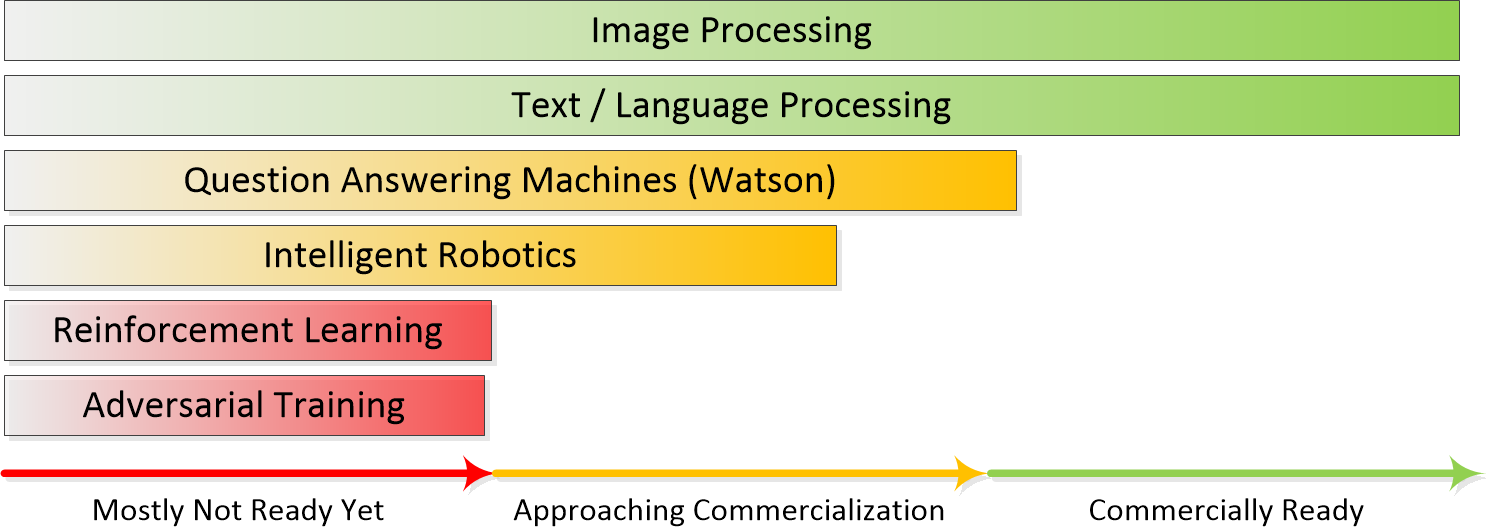
To come back to the PwC predictions, the one that most resonated with me is “AI will come down to earth and get to work”. Business should leave the yet-to-come technologies to the researchers and focus on what’s ready now.
Do You Really Want an AI Strategy?
First of all we’re going to assume that these respondents could actually tell what is AI and what is not within their data-driven strategies. It’s not entirely clear. There is this growing trend on the part of the popular press, analytic platform vendors, and AI researchers to say that everything within data science is AI.
Let’s start by agreeing that predictive analytics that has existed outside of deep learning for almost two decades is not AI. It broadly helps humans make better decisions (e.g. who will buy, who will churn, is that fraud, what will the price be) but it does not perform extended human-like tasks like making coffee or even holding a decent casual conversation. Predictive analytics also still represents about 95% of what we are paid to do in data science.
If you’re in our leader group (hospitality, consumer, and financial services) then you know this intuitively because you’ve been using it. At the other end of the adopter scale, I’m not so sure they are accurately differentiating.
Still, while few companies today actually have an AI strategy (most surveys show numbers in the mid-teens, say around 15%), a much larger group intends to have an AI strategy.
Incremental versus Fundamental Improvements
When identifying strategic opportunities for your AI portfolio it’s important to differentiate and not overlook the applications for which there is incremental improvement versus fundamentally new capabilities. Here are some examples: 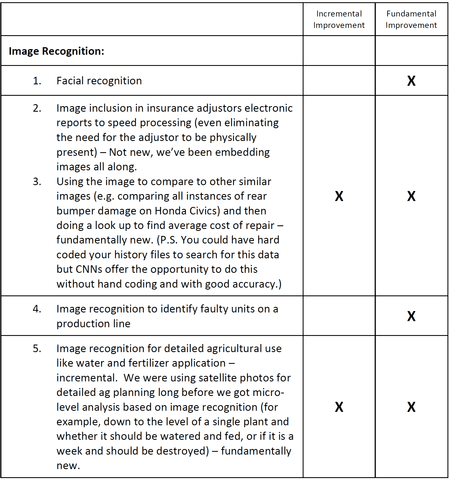
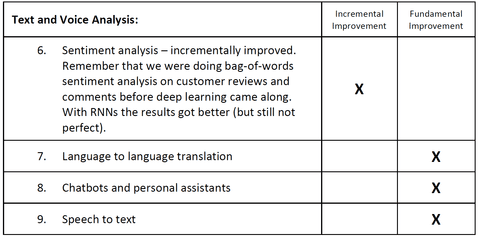
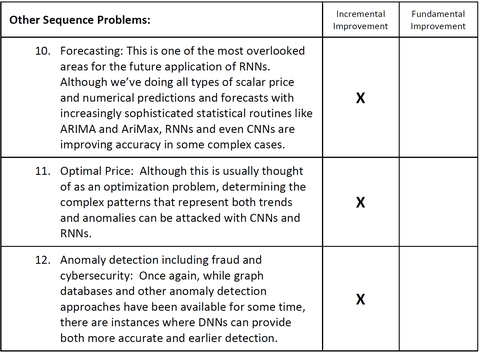
Developing the AI Portfolio of Projects
Once a company has committed to an AI initiative and gone through the process of defining strategic goals that could benefit from AI, the next step is to create and refine a Portfolio of AI Projects.
This is not significantly different from the many well-known processes for developing targeted portfolios or for estimating their potential value, cost, time, interdependencies, risks, and other factors to be considered.
What is different are the skills needed of the participants in this project. Increasingly data science including AI is becoming a team project involving data scientists, IT, analysts, and most important LOB managers.
The key skill in the success of this effort is the ability to recognize and clearly state a business opportunity as a data science (AI) question. Given that data scientists are still rare and will not be the source of the best business understanding, the focus should increasingly be the LOB manager.
Over the last several years the concept of Citizen Data Scientist has been widely discussed. Early definitions (and those most supported by the platform vendors) included the Citizen Data Scientist actually hands-on operating data science platforms that had been sufficiently simplified to allow this. The new definition focuses on the higher level task of knowing when a business opportunity is a suitable target for AI (or predictive analytics) and knowing broadly which techniques are appropriate.
If your company is anticipating developing an AI strategy (or expanding its use of data science broadly), the appropriate first step is to train or select for LOB managers who understand the AI techniques and their application sufficiently to lead the team defining the AI portfolio project.
Other articles on AI Strategy
Comparing the Four Major AI Strategies
Comparing AI Strategies – Systems of Intelligence
Comparing AI Strategies – Vertical versus Horizontal.
What Makes a Successful AI Company – Data Dominance
Other articles by Bill Vorhies.
About the author: Bill Vorhies is Editorial Director for Data Science Central and has practiced as a data scientist since 2001. He can be reached at:
